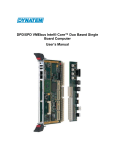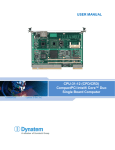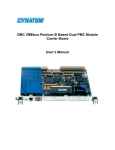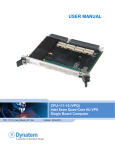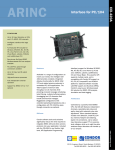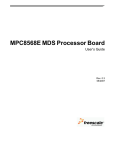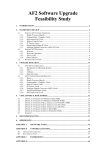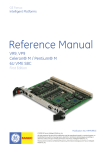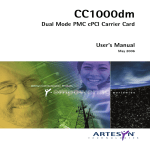Download CPM1/CRM1 cPCI Pentium M Based Single Board
Transcript
CPM1/CRM1 cPCI Pentium M Based Single Board Computer User’s Manual CPM1 User’s Manual Rev. 1.01 May 2006 Dynatem 23263 Madero, Suite C Mission Viejo, CA 92691 Phone: (949) 855-3235 Fax: (949) 770-3481 www.dynatem.com Table of Contents 1. Features 1 2. Related Documents 3 3. Hardware Description 5 3.1 3.2 3.3 3.4 3.5 3.6 3.7 3.8 3.9 3.10 3.11 4. Overview Processor Chipset DRAM Intel 82546EB Dual Gigabit Ethernet Controller Intel 82541 Fast Ethernet Controller PLX PCI-cPCI Interface PCI Mezzanine Card (PMCX) Expansion Intel’s FW82802A Firmware Hub Holds the System BIOS In Flash Memory Clock Drivers IPMI & Reset Circuitry & LEDs Installation 4.1 4.2 4.3 4.4 4.5 Dynatem 5 6 6 7 7 8 9 11 11 12 12 15 Installing CPM1 in a CompactPCI Chassis Jumper Selectable Options CompactFlash Drive Installation PCI Mezzanine Card (PMC) Installation Front Panel Connectors and Reset Switch CPM1 cPCI Pentium Processor Board – User’s Manual 15 15 17 17 18 i A. A.1 A.2 A.3 A.4 A.5 A.6 A.7 A.8 B. B.1 B.2 B.3 Connector Pin-outs 19 COM1 & COM2 Front Panel Connector (J8) 1 Gb Ethernet Front Panel Connector (J9) CompactFlash Interface Connector (J6) PS/2 Mouse/Keyboard Connector (J10) JTAG Debug Port (J13) cPCI Connectors (J1, J2, J3, & J5) PCI-X Mezzanine Card (PMC1) Connectors (JN1, JN2, JN3, and JN4) PCI Mezzanine Card (PMC2) Connectors (JN1 & JN2) Address Maps, Interrupts, DMA Channels Memory Map PCI Configuration Space Map Interrupt Request Routing 20 20 21 21 22 23 26 30 33 33 33 34 C. Power and Environmental Requirements 35 D. XPM1RIO Rear Plug-in I/O Expansion Module 37 ii CPM1 cPCI Pentium Processor Board – User’s Manual Dynatem Chapter 1 – Features 1. Features The Dynatem CPM1 is a single-slot 6U cPCI Single Board Computer (SBC). The CPM1 offers full PC performance with a Pentium M low-power processor. The CPM1 is available in two versions: the lower cost CPM1 for standard industrial applications and the 1101.2 compliant, conduction-cooled CRPM1 with wedgelocks, stiffener bar, and a full board heatsink for rugged applications. When referring to attributes of both versions, we will use the name CPM1. The CPM1 employs Intel’s embedded technology to assure long-term availability. Features of the CPM1 include: • Single-slot cPCI operation with on-board CompactFlash disk for bootable mass storage and front panel connectors for two RS232/485 COM ports, a 1 Gb Ethernet port, I/O for two PMC sites, and PS/2 Mouse/Keyboard ports. • Primary IDE, DVI-I graphics, four USB 2.0 ports, two Serial ATA ports, and Super I/O generated Floppy Disk drive interface and undriven COM3 & 4 ports are routed out to the backplane via the J5 connector • Two Gb Ethernet ports (in compliance with PICMG 2.16) and PMC I/O for Slot B (in compliance with PICMG 2.3 R1.0) are routed to J3 Dynatem CPM1 cPCI Pentium Processor Board – User’s Manual 1 Chapter 1 – Features • The Intel® 855GME Graphics Memory Controller Hub (GMCH) and Intel® 6300ESB I/O Controller Hub (ICH) provide high-speed memory control, built-in graphics, integrated I/O including Serial ATA, USB 2.0, IDE supporting Ultra 100 DMA Mode for transfers up to 88.88 MB/sec, and 64 bit PCI-X bus transfers at 66 MHz • Intel’s 82541 10/100BaseTX interface accessible at the front panel • Intel’s 82546 Ethernet Controller offers two 10/100/1000BaseTX support routed to J3 in compliance with PICMG 2.16 for backplane fabric switching • Up to 1 GB of DDR DRAM provided on-board • PLX PCI6254 dual mode Universal asynchronous 64 bit 66 MHz PCI-PCI bridge lets the CPM1 act as a peripheral card or system slot module • Pigeon Point’s IPM Sentry offers IPMI system management in compliance with PICMG 2.9 • Two PCI Mezzanine Card (PMC) expansion sites are supported: one supports up 64 bits @ up to 66 MHz while the other supports 32 bit modules at 33 MHz • Secondary IDE port for CompactFlash on-board for flash-based mass storage for single-slot booting • General Software’s flash-based system BIOS • PXE for diskless booting over Ethernet • Operating System (OS) and driver support, including Windows NT, Embedded NT, XP, QNX, VxWorks, Linux, Solaris, and pSOS+ 2 CPM1 cPCI Pentium Processor Board – User’s Manual Dynatem Chapter 2 – Related Documents 2. Related Documents Listed below are documents that describe the Pentium processor and chipset, and the peripheral components used on the CPM1. Either download from the Internet or contact your local distributor for copies of these documents. The CPM1 uses the Low Voltage Pentium M. For information on this processor, go to: http://www.intel.com/design/intarch/pentiumm/pentiumm.htm For the ICH component in the 6300ESBchipset get the Intel ® 6300ESB I/O Controller Hub Datasheet. It is document number 300641-003. http://www.intel.com/design/intarch/datashts/300641.htm For the GMCH component in the chipset get the Intel ® 855GM/855GME Chipset Graphics and Memory Controller Hub It is document number 252615-005: . http://www.intel.com/design/chipsets/datashts/252615.htm (GMCH) Datasheet. For data sheets on I/O controllers: • 82546EB Fast Ethernet PCI Controller http://developer.intel.com/design/network/products/lan/controllers/82546.htm • 82541EI Ethernet PCI Controller http://developer.intel.com/design/network/products/lan/controllers/82541ei.htm • CompactPCI Specification PICMG 2.0 R3.0 and other CompactPCI Specifications: http://www.picmg.org/compactpci.stm#CompactPCISpecifications The following documents provide information on the PC architecture and I/O: • PCI Local Bus Specification, Revision 2.2 http://www.pcisig.com/specifications/ • PCI-X Specification, Revision 1.0A http://www.pcisig.com/specifications/ • System Management Bus Specification (SMBus), Revision 1.1 http://www.smbus.org/specs/ • Universal Serial Bus Specification http://www.usb.org/developers The following documents cover topics relevant to the cPCI and can be purchased through VITA: • IEEE Std 1014-1987, IEEE Standard for a Versatile Backplane Bus: cPCI The Institute of Electrical and Electronic Engineers 345 East 47th Street New York, NY 10017 (800) 678-4333 Dynatem CPM1 cPCI Pentium Processor Board – User’s Manual 3 Chapter 2 – Related Documents The following documents are the current draft standards for the PCI Mezzanine Card (PMC): • IEEE Draft Std P1386/2.0, Draft Standard for a Common Mezzanine Card Family: CMC The Institute of Electrical and Electronic Engineers 345 East 47th Street New York, NY 10017 (800) 678-4333 • IEEE Draft Std P1386.1/2.0, Draft Standard Physical and Environmental Layers for PCI Mezzanine Cards: PMC The Institute of Electrical and Electronic Engineers 345 East 47th Street New York, NY 10017 (800) 678-4333 4 CPM1 cPCI Pentium Processor Board – User’s Manual Dynatem Chapter 3 – Hardware Description 3. Hardware Description 3.1 Overview The block diagram of the CPM1 is shown below. The sections that follow describe the major functional blocks of the CPM1. Dynatem CPM1 cPCI Pentium Processor Board – User’s Manual 5 Chapter 3 – Hardware Description 3.2 Processor The CPM1 supports a Pentium M processor at 1.4 GHz. The Intel Pentium M processor with 2 MB of L2 cache is meet the current and future demands of high-performance, low-power embedded computing, making it ideal for communications, mobile applications, vehicles, and industrial automation applications. While incorporating advanced processor technology, it remains software-compatible with previous members of the Intel® microprocessor family. • 400 MHz front side bus. • 4 MB of L2 cache for fast large-table look-ups: routing tables. • Advanced branch prediction, Micro-op fusion, Hardware stack manager for faster processing. • Second-generation Streaming SIMD Extensions (Streaming SIMD Extensions 2) capability adds 144 new instructions, including 128-bit SIMD integer arithmetic and 128-bit SIMD double-precision floating-point operation. • Fully compatible with existing Intel® Architecture-based software. For further information on the Pentium M processor available from Intel Corporation, search at: http://www.intel.com/design/intarch/pentiumm/pentiumm.htm The Intel® Pentium® M processor was designed from the ground up with a new microarchitecture that delivers high performance with low power consumption. With its 90 nm processing technology and 2 MB of L2 advanced transfer cache, the Pentium M offers more performance per Watt. The Pentium M also offers a dedicated hardware stack manager that employs sophisticated hardware control for improved stack management, advanced branch prediction capability, and a 400 MHz front side bus to the memory controller hub. 3.3 Chipset The Intel® 855GME Graphics Memory Controller Hub (GMCH) and Intel® 6300ESB I/O Controller Hub (ICH) chipset create an optimized integrated graphics solution with a 400 MHz system bus and integrated 32-bit 3D core at 133 MHz. The 855GME (GMCH) provides a 266 MHz interface to DDR RAM (72 bits wide with ECC). The CPM1 can be populated with one or two banks of DRAM for 512 MB or 1 GB of total memory respectively. The GMCH system memory architecture is optimized to maintain open pages (up to 16-kB page size) across multiple rows. As a result, up to 16 pages across four rows is supported. To complement this, the GMCH will tend to keep pages open within rows, or will only close a single bank on a page miss. The 855GME also has an advanced integrated graphical display controller. The CPM1 routes the DVO B port through a PanelLink device and this, along with the VGA port, is brought out through the J5 connector to the system backplane. The XPM1RIO rear plug-in card combines the the DVO and VGA ports in a DVI-I connector. The DVO port: 6 • Provides high-speed, 12-bit interfaces with 165 MHz dot clocks • Supports DVO devices (TV-Out Encoders, TMDS & LVDS transmitters, etc.) with pixel resolutions up to 1600 x 1200 @ 85 Hz and up to 1048 x 1536 @ 72 Hz CPM1 cPCI Pentium Processor Board – User’s Manual Dynatem Chapter 3 – Hardware Description • Compliant with DVI Specification 1.0 • Front side system bus bandwidth of 3.2 GB/s (400 MHz). The 6300ESB I/O Controller Hub (ICH) provides most of the CPM1’s on-board I/O and it’s the CPM1’s PCI and PCI-X expansion bridge. The ICH is designed as a low-power, high-performance I/O hub that features: • 64-bit @ 66 MHz PCI-X expansion that is used on the CPM1 for the on-board PMC-X slot, the two Ethernet ports available in compliance with PICMG 2.16, and for the PLX PCI6254 PCI to PCI bridge to the backplane • 32-bit @ 33 MHz PCI bus that supports the second PMC site and the front panel’s Gb Ethernet port • Four USB 2.0 compliant ports that are routed to the J5 connector to the backplane and to the optional XPM1RIO rear I/O module where industry standard USB connectors are provided • Integrated IDE controller supports Ultra 100 DMA Mode Transfers for up to 100 MB/sec read cycles and 88.88 MB/sec write cycles for a CompactFlash drive on-board and a primary IDE port that is routed through J5 to the XPM1RIO • Two Serial ATA ports providing 150 MB/sec data rates are routed through J5 • Standard PC functionality like a battery-backed RTC and 256-bytes of CMOS RAM, Power Management Logic, Interrupt Controller, Watchdog Timer, AC’97 CODEC, Integrated 16550 compatible UART’s, and multimedia timers based on the 82C54 For further information, see the documents referenced in Section 2 3.4 DRAM The CPM1 supports a 72-bit wide, DDR-266 memory interface with memory bandwidth of 2.1 GB/s with ECC. The module can be populated to support 512 MB or 1 GB of DRAM. 3.5 Intel 82546EB Dual Gigabit Ethernet Controller The CPM1 supports two 10/100/1000BaseTX channels accessible from the backplane. The Intel 82546EB Dual Port Gigabit Ethernet Controller incorporates two full Gigabit Ethernet MAC and PHY layer functions on a single, compact component. The CPM1 uses the PCI-X interface of the ICH to control the 82546EB. Therefore, the front side data path to the dual Ethernet port controller is 64 bits at 66 MHz. The Intel 82546EB offers the following features: • 10, 100, and 1000BaseTX support with auto-negotiation • Dual 64KB configurable RX and TX packet FIFOs • 128-bit internal data path architecture for low latency data handling and superior DMA transfer rate performance • Built-in Phyceiver • Serial EEPROM for non-volatile Ethernet address storage Dynatem CPM1 cPCI Pentium Processor Board – User’s Manual 7 Chapter 3 – Hardware Description Both 10/100/1000BaseTX ports of the 82546 device are brought out to the J3 backplane connector in compliance with the PICMG 2.16 specification. PICMG 2.16 lets the user implement fabric switching on the backplane where 2.16 compliant SBC’s can communicate with each other and with an external network through switch modules that are located at either end of the backplane. Optionally these two 1 Gb Ethernet ports are brought to industry standard RJ-45 connectors on Dynatem’s rear I/O plug-in module (CPM1PTB). The Intel 82546 contains several PCI configuration registers. It also contains a number of device registers for controlling the Ethernet operation that can be mapped to the memory space or the I/O space. The PCI signals specific to the CPM1’s 82546 are shown below: 3.6 Intel 82546 Signal PCI Bus Connection Bus IDSEL PREQ PGNT PIRQ for Port A PIRQ for Port B 2 AD18 (Device 2) PX_REQ1# PX_GNT1# PX_IRQ1 PX_IRQ2 Intel 82541 Gb Ethernet Controller For A Front Panel LAN Port The Intel 82541PI offers the following features: • 10, 100, and 1000BaseTX support with auto-negotiation. • Independent 64 KB RX and TX FIFO where the apportionment is tunable to the application. • Transmit TCP segmentation IP, TCP, and UDP checksum offloading. • Built-in Phyceiver. • Serial EEPROM for nonvolatile Ethernet address storage. The 10BaseT/100/1000BaseTX signals are brought out to J9, an RJ-45 connector with built-in magnetics on the front panel. The connector also features three functioning LEDs: for Linkup, Network Activity, and 1 Gb Link. The LEDs are controlled by the Ethernet circuitry. The pin-out for J9 is given in Appendix A. The Intel 82541 contains several PCI configuration registers. It also contains a number of device registers for controlling the Ethernet operation that can be mapped to the memory space or the I/O space. The 82541 is controlled by the PCI interface of the ICH. The PCI signals specific to the Intel 82541 are shown below: 8 Intel 82541 Signal PCI Bus Connection Bus IDSEL PREQ PGNT PIRQ 3 AD17 (PCI Device 0) REQ1# GNT1# INTG# CPM1 cPCI Pentium Processor Board – User’s Manual Dynatem Chapter 3 – Hardware Description For further information on the 82541, refer to 82541 Fast Ethernet Multifunction PCI/Cardbus Controller, available from Intel Corporation. Please go to the link at: http://www.intel.com/design/network/products/lan/controllers/82541ei.htm 3.7 PLX PCI6254 & PC6540PCI-cPCI Interfaces (Section Under Construction) The CPM1 uses two different PCI bridges to the backplane depending on the revision of the module. The first revision of the board (identified by “PWB 010 6057 002” etched on the printed circuit board near the top card puller) uses PLX’s PCI6254 PCI-PCI bridge. On subsequent versions of the CPM1 this chip was replaced by the PLX PCI6540 as it supports PCI-X to PCI-X transfers and the primary side of the bridge is shared with the PCI-X compatible 82546 dual 1 Gb Ethernet controller chip and possibly PCI-X compatible PMC modules in PMC site #1. These peripherals cannot operate in PCI-X mode if they share their PCI bus interface with the PCI6254. The PCI-cPCI interface, based on the PLX PCI 6254 on PWB 010 6057 002, offers the following features: • 64-bit, 33MHz-66MHz Asynchronous operation • 1 KB FIFO for efficient PCI-PCI bridging and speed conversion. • Transparent and non-transparent bridge operation. • Usable in the cPCI system slot or a peripheral slot. • Supports hot swapping to eliminate the mid-transaction extraction problems associated with cPCI. The block diagram of the PCI-PCI interface is shown below: 6300ESB Input/Output Controller Hub IPMI & Reset LPC Hot Swap Control PCI-X @ 66 MHz 82546 Dual 1 Gb LAN Controller PMC-X Site #1 I/O IPMI PCI-X interface cPCI P1 Connector PCI6254 on boards PWB D010 6057 002 (no PCI-X) PCI6540 on boards PWB D010 6057 003 and later (PCI-X) SYSEN# determines system slot or peripheral operation. AD32 – AD63 cPCI P2 Connector I/O from PMC-X P14 cPCI P3 Connector PCI-cPCI Backplane Interface Block Diagram Dynatem CPM1 cPCI Pentium Processor Board – User’s Manual 9 Chapter 3 – Hardware Description The PCI-X to cPCI-X interface, based on the PLX PCI 6540, offers the following features: • 64-bit PCI-X r1.0b compliant asynchronous operation (limited to 66MHz by the 6300ESB south bridge) • 10 KB FIFO for efficient PCI-X to PCI-X bridging and speed conversion. • Transparent and non-transparent bridge operation. • Usable in the cPCI system slot or a peripheral slot. As shown in the block diagram, the PCI bridge to the backplane shares its primary side with the 82546 Dual Gb Ethernet controller and PMC site #1. If the PMC card installed in site #1 is not PCI-X compatible, then neither the PCI bridge nor the 82546 can operate in the PCI-X mode. The same is true with the bridge chip. Therefore the CPM1 cannot support PCI-X on site #1 PMC cards or on the 82546 on boards that use the PCI6254. The same is true with clock frequencies: the PCI bus can only run as fast as the slowest device on the bus so a PMC module running at 33 MHz will force the 82546 and the PCI-PCI bridge to operate at 33 MHz. Both the 6254 and the 6540 are universal bridges, meaning their mode of operation is determined by the SYSEN# signal on the cPCI backplane. In this application, the CPM1 can be used without jumpers for the system slot or peripheral slot in a CompactPCI system. The bridge senses the type of slot (system or peripheral) and configures itself as Transparent or Non-Transparent respectively. In the system slot, the CPU is expected to operate as a host, and the bridge operates in Transparent mode. In the peripheral slot, the CPU is part of an intelligent subsystem, and the bridge is configured in Non-Transparent mode. The figure below shows: C CLK3, CLK5 (6540) o m CLK3 p CLK0 a Transparent PCI c PCI Bridge t REQ0 P C CLK4 GNT0 I CPM1 Pentium M LAN CPM1 Pentium M CLK0 PCI Non-Trans PCI Bridge REQ0 LAN GNT0 PMC PMC CLK4, CLK6 (6540) System Slot b u s Peripheral Slot This drawing shows how the CPM1 operates differently depending on whether it’s in the system slot on the backplane (denoted by a triangle) or one of the remaining peripheral slots (denoted by circles silkscreened on the backplane). When in the system slot the six additional REQ/GNT pairs and six additional clocks are routed to the backplane in compliance with the PICMG CompactPCI spec (though boards using the PCI6540 route CLK3 to the pins assigned to CLK3 and CLK5 and CLK4 to CLK4 and CLK6 because the 6540 only has five CLK output lines 10 CPM1 cPCI Pentium Processor Board – User’s Manual Dynatem Chapter 3 – Hardware Description available). These additional CLK and REQ/GNT lines are not used when the CPM1 is installed in a peripheral slot. They are in a tristate mode. A transparent PCI bridge is meant to provide electrical isolation to the system. It allows additional loads (and devices) to be attached to the bus, and can also be used to operate dissimilar PCI Bus data widths and speeds on the same system. For example, a transparent bridge can allow several 32-bit, 33 MHz PCI devices to attach to a 64-bit, 66 MHz PCI-X slot. A non-transparent PCI bridge offers address isolation in addition to electrical isolation. Devices on both sides of the bridge retain their own independent Memory space, and data from one side of the bridge is forwarded to the other side, using an address translation mechanism. A non-transparent bridge is used when there is more than one intelligent entity (such as multiple processors) in the system. It is a common mechanism used for creating intelligent I/O cards and multi-processor systems. The bridge is CompactPCI Hot Swap Ready, and complies with PICMG 2.1 R2.0 with High Availability Programming Interface level 1 (PI = 1). The CPM1 reset circuitry is tied to the bridge, since the CPM1 can generate the cPCI SYSRESET* signal as well as be reset by another cPCI board that asserts the SYSRESET* signal. The CPM1 reset circuitry is discussed in detail in Section 3.12. This section supplements the PCI-to-PCI Bus Bridge documentation (downloadable from PLX Technology’s website at http://www.plxtech.com/products/fastlane_bridges/default.asp), which contains comprehensive descriptions of the operation and programming of the PCI 6254 and PCI6540 devices. 3.8 PCI-X Mezzanine Card (PMCX) and PMC Expansion The CPM1 has two PMC I/O expansion slots: one 64-bit PCI-X compatible site and one 32-bit at 33 MHz site. The CPM1 supports a PCI-X Mezzanine Card (PMC) site on-board where the I/O can be routed out through the J3 connector (please see Appendix A) or accessed from the front panel. This first PMC site shares its PCI-X bus with the PCI bridge to the backplane and with the 82546GB dual 1 Gb Ethernet controller that provides two PICMG 2.16 compliant LAN ports through J3 to the backplane. This site supports 64-bit PCI-X transfers at 66 MHz. 33 MHz PMC cards or PMC cards not capable of PCI-X transfers can be used in this site but they will limit the 82546GB and the PCI bridge to their capabilities – see Section 3.7. The CPM1 also provides a 32-bit @ 33 MHz PMC site that shares its PCI bus with the 82541PI front panel Ethernet port. I/O is only accessible from the front panel – it is not routed to the backplane as with the PMC site. Both sites are compliant with ANSI/VITA 20-2001 for conduction-cooled systems. Conduction cooled PMC modules are recommended for use with the CRPM1 rugged version. 3.9 Intel’s FW82802AC Firmware Hub Holds the System BIOS In Flash Memory The Intel FW82802AC uses a 5-pin interface and provides 1 MByte of flash memory for the system BIOS. This device can fill the 1 MB real mode memory map so only a portion its upper 256 MB is used. The FW82802AC’s 1 MB of memory space is segmented into sixteen parameter blocks of 64 KB each. The CPM1 powers up into real mode and the BIOS is eventually shadowed into system DRAM after booting through the BIOS. The 6300ESB Southbridge provides the 5-pin interface to the E82802AC. The upper 256 KB of the E82802AC is located from 000C0000 - 000FFFFF and its full 1 MB of memory is aliased from FFF00000 – FFFFFFFF where it can be fully accessed after booting up through the BIOS. Here’s a link to a datasheet for the 82802AC: ftp://download.intel.com/design/chipsets/datashts/29065804.pdf Dynatem CPM1 cPCI Pentium Processor Board – User’s Manual 11 Chapter 3 – Hardware Description 3.10 Clock Drivers The clock driver circuitry is shown below: Cypress 28409 14.31818 MHz Crystal 32.768 KHz Crystal Pentium M CPU 100 MHz differential clocks for GMCH, ICH, ITP, & CPU clocks To ICH for Real Time Clock ICH ITP Port 48 MHz Two 25.0 MHz Oscillators To GMCH for SDRAM Clocks Routed to ICH for USB and UART’s and to the GMCH for Graphics To Ethernet Controllers 82546 & 82541 and Watchdog To ICH for USB & Serial To GMCH for dot clocks Clock Driver Circuitry The clocks are generated by the Cypress 28409, which is driven by a 14.31818 MHz crystal. DRAM clocks are synthesized by the GMCH and Hub Interface and PCI(-X) clocks are produced by the ICH. A 32.768 KHz Crystal drives the Real Time Clock (RTC) on the ICH. The Fast Ethernet port provided to the front panel by the 82541 and the two 1 Gb Ethernet ports provided to the backplane by the 82546 require separate 25.0 MHz oscillators (one of the two oscillators is also used for the watchdog timer clock). A 64.0 MHz oscillator drives the PCI 6254cPCI circuitry. 3.11 IPMI & Reset Circuitry & LEDs The CPM1, with Pigeon Point System’s Data Sentry system, implements the mandatory management interfaces defined by the PICMG 2.9 specification to be supported in connection with an IPM Controller. Optional features are listed below. Several of these signals are required to be supported in cPCI boards that comply with specific PICMG 2.x specifications (such as PICMG 2.1 or PICMG 2.16 for the first four signals below), but with no corresponding requirement that the IPM Controller on a board have any particular responsibility or control regarding them. • BD_SEL# signal • Handle switch • Hot swap LED • HEALTHY# signal • Fan control and monitoring 12 CPM1 cPCI Pentium Processor Board – User’s Manual Dynatem Chapter 3 – Hardware Description The reset circuitry is shown below: PCI-PCI Bridge to the CompactPCI Backplane 3 Volts cPCI SYSRESET Blue LED on front panel means eject is OK. ENUM# Atmel ATmega 128L IPMI Controller Ejector Handle Front Panel Reset Switch (& PRST# on backplane) VCSR_SET[RES] PB1 J7 BD_SEL# SYSRESET# Payload Interface I2C Super I/O 6300ESB ICH I2C LPC Interface PCI Reset PCI peripherals SYSRESET# Reset Control Register Vcore Monitor Pentium M “soft” reset PWRGD_VR Pentium M “hard” reset 2.5 V Good Reset Circuitry Dynatem CPM1 cPCI Pentium Processor Board – User’s Manual 13 Chapter 3 – Hardware Description There are multiple ways to perform a hard reset of the CPM1: • A simple power cycle (turn the chassis’ power off and on). • There are two options for using a push button reset: the momentary push button switch that’s accessible at the CPM1’s front panel near the lower ejector handle; the PRST# signal on the backplane (connector J2, pin C17) that is generally connected to the chassis’ reset button. • When the CPM1 is installed in a peripheral slot it can be reset by the system controller module through a conventional PCI Reset. • A DS1233 monitors the on-board 3.3 VDC, regulated from the 5.0 VDC off the backplane, and provides proper power sequencing for the CPU. • A hot swap removal of the CPM1 from the chassis. When the ejector handles are released and the blue front panel LED is lit, the board has been reset and it it safe to remove the CPM1 completely from the chassis For further information on the peripherals that play a part in the reset circuitry, refer to ICH datasheet that’s referenced in Section 2. There are four FRU LEDs that are routed from the IPMI controller and they are located near the front panel on the solder side of the CPM1 under PMC site #2. These LEDs cannot be seen when through the front panel. Here is the signal – LED correspondence: 14 Atmel ATmega 128L IPMI Controller Pin LED MOSI/PB2 MISO/PB3 OC0/PB4 OC1/PB5 D11 Green D11 Red D12 Green D12 Red CPM1 cPCI Pentium Processor Board – User’s Manual Dynatem Chapter 4 – Installation 4. Installation The following sections cover the steps necessary to configure the CPM1 and install it into a cPCI system for singleslot operation. This chapter should be read in its entirety before proceeding with the installation. This section explains how to set up user configurable switches and jumpers and how to install CompactFlash drives and PMC modules. The CPM1 is shipped in an antistatic bag. Be sure to observe proper handling procedures during the configuration and installation process, to avoid damage due to electrostatic discharge (ESD). 4.1 Installing the CPM1 in a CompactPCI Chassis The CPM1 features a Universal PCI(-X)-PCI(-X) bridge to the backplane. Without changing any jumpers the CPM1 will operate as a system slot card (coming up in transparent mode whereby it can initialize peripheral cards on the backplane) when installed in the system slot or as a peripheral card in peripheral slots (coming up in nontransparent mode so that initialization will be done locally without interference from the system slot processor board). 4.2 Jumper Selectable Options The CPM1 contains three jumpers and a surface-mount piano switch for system configuration. The jumper, switch, PMC site, and CompactFlash socket are indicated in the photo below: PMCX Site (inside hashed line) JP2 PMC Site JP3 JP1 J7 SW1 Dynatem CompactFlash Socket CPM1 cPCI Pentium Processor Board – User’s Manual 15 Chapter 4 – Installation The CPM1 offers a number of user configurable hardware options. Jumpers Description JP1 JP2 JP3 SW1-1 SW1-2 SW1-3 through SW1-6 SW1-7 SW1-8 Grounds PRV_DEV/XB_MEM when shunted Determines VIO for the PMCX site #1 (1 – 2 for 3.3 VDC; 2 – 3 for 5.0 VDC) Determines VIO for the PMC site #2 (1 – 2 for 3.3 VDC; 2 – 3 for 5.0 VDC) COM1 is in RS-232 mode when closed; RS-4xx when open COM2 is in RS-232 mode when closed; RS-4xx when open Unused Close momentarily to flush RTC and NV-RAM and revert to BIOS defaults MUST STAY CLOSED (on-board BIOS is disabled when open) Jumper JP1 determines the status of PRV_DEV/XB_MEM. PRV_DEV(when in the Transparent Mode): When set to 1, the PCI 6540 can mask secondary devices using IDSEL connected to S_AD[23:16] as private devices. Any Type 1 Configuration access to these IDSELs is routed to AD24. If there is no device on S_AD24, the re-routed Type 1 Configuration cycles are Master Aborted. The PCI 6540 also reserves Private Memory space for the secondary port. The Memory space can be programmed using the Private Memory Base and Limit registers (Base—PVTMBAR; PCI:6Ch and VTMBARU32; PCI:70h, Limit—VTMLMT; PCI:6Eh and PVTMLMTU32; PCI:74h). If the limit is smaller than the base, Private Memory space is disabled. The primary port cannot access this Memory space through the bridge and the secondary port does not respond to Memory cycles addressing this Private Memory space. XB_MEM(when in the Non-Transparent Mode): When set to 1, the PCI 6540 automatically claims 16 MB of Memory space. This allows the boot-up of the LowPriority Boot port to proceed without waiting for the Priority Boot port to program the corresponding Memory Base Address registers (BARs). Although the default claims 16 MB, the BARs can be modified by serial EEPROM or software to change the window size. If XB_MEM=1, the P_PORT_READY or S_PORT_READY mechanism is not relevant. Also, if XB_MEM=1, the PCI 6540 autoloads serial EEPROM data up to Group 5 instead of Group 4. . PRV_DEV/XB_MEM Grounded, Logic 0 Logic 1 PMCX Site #1 Signaling Voltage Selection JP1 Closed Open Jumpers JP2 & JP3 select the VIO routed to the CPM1’s PMCX & PMC modules respectively. The VIO pins determine the signaling voltage on the PMC(X) modules’ PCI(-X) interface. Refer to the PMC module’s reference manual to ascertain the recommended VIO. Shunting pins 1 & 2 of JP2 & JP3 provides a VIO of 3.3 VDC. Shunting between pins 2 & 3 routes 5 VDC to the VIO pins on the PMC(X) module. VIO Voltage Level 3.3 VDC (Necessary for PCI-X Operation) 5 VDC PMCX Site #1 Signaling Voltage Selection 16 CPM1 cPCI Pentium Processor Board – User’s Manual JP2 1-2 2-3 Dynatem Chapter 4 – Installation VIO Voltage Level JP3 3.3 VDC 5 VDC PMC Site #2 Signaling Voltage Selection 1-2 2-3 The SW1 switches are closed when in the “on” position. Switch SW1-1 determines the communication mode under which the CPM1’s COM1 port will operate, RS-232 or RS-422/485. COM1 Mode Selection RS-4xx Mode RS-232 Mode COM1 Selection SW1-1 Open Closed Switch SW1-2 determines the communication mode under which the CPM1’s COM2 port will operate, RS-232 or RS-422/485 COM2 Mode Selection RS-4xx Mode RS-232 Mode COM2 Selection SW1-2 Open Closed Switch SW-7 should be closed momentarily (for about 30 seconds) to restore the default BIOS settings. SW1-8 should always be closed (in the “on” position) – this switch is used for factory use. 4.3 CompactFlash Drive Installation The CPM1 supports a bootable CompactFlash Drive for single-slot booting. Connector J4 is a Type II CompactFlash connector and is used for this purpose. J4 is located behind the front panel Ethernet connector on the CPM1’s printed circuit board. 4.4 PCI Mezzanine Card (PMC) Installation The CPM1 supports two add-on module sites that let the user expand the CPM1’s local I/O with PCI Mezzanine Card (PMC) or PMCX (PMC modules capable of PCI-X transfers) cards. Only one of the two sites (located in the middle of the CPM1 and labeled “PMC1” on the front panel) supports PMCX cards that, in turn, support PCI-X transfers at a maximum of 66 MHz. The PMCX site is backwards compatible and can support any module from 32bit PMC cards at 33 MHz to 64-bit PMCX modules at 66 MHz, however, it shares a bus with the 82546EB dual Gb LAN controller used for PICMG 2.16 compliance and the PCI6540 PCI-X to PCI-X bridge to the cPCI backplane. Putting a standard PMC card in this site will force the 82546EB and the PCI6540 to operate in standard PCI mode. The CPM1’s PCI-X bus interfaces to the 82546 dual Gb Ethernet controller and to the PMCX site. PMCX site Available Data Rates with VIO = 5 V (JP3 is shunted between pins 2 & 3) Available Data Rates with VIO = 3.3 V (JP3 is shunted between pins 1 & 2) 1 33 MHz 33 MHz and 66 MHz The General Software BIOS will determine during startup what the status is on the installed PMC(X) card. The BIOS monitors the following pins that are routed to the ICH: PCIXCAP (PCX-X capable and it is pin 39 on Dynatem CPM1 cPCI Pentium Processor Board – User’s Manual 17 Chapter 4 – Installation connector P11) and M66EN (66 MHz capable and pin 47 on connector P12). The user’s manual on your PMC(X) modules will tell you how PCIXCAP (JN1, pin 39) and M66EN (JN2, pin 47) are configured. If either is grounded than the PMC(X) module does not have the corresponding capability (these pins were assigned as ground on the original PMC specification before PCI-X or 66 MHz modes of operation were supported). Conventionally PMC connectors have four designators: JN1 – JN4. JN1 & JN2 provide all the signals necessary for 32-bit PCI transactions, JN3 has the 32 additional data lines required for 64-bit transfers, and JN4 routes I/O off the module for possible backplane access (see Section A for JN4 to P2 backplane PMCX I/O routing). The following table lists the reference designators used on the CPM1’s PMC(X) site: PMC1 site JN1 JN2 JN3 JN4 1 P11 P12 P13 P14 The second PMC site, labeled PMC2 on the front panel, only supports 32-bit PCI transactions at 33 MHz. There is no JN3 connector for 64-bit transfers and there’s no JN4 connector to route I/O to the backplane. The following table lists the reference designators used on the CPM1’s second PMC site: 4.5 PMC2 site JN1 JN2 JN3 JN4 1 P21 P22 N/A N/A Front Panel Connectors and Reset Switch The CPM1 offers front panel connections for two COM ports, one PS/2 connector for a combined mouse/keyboard interface, and an RJ45 connector for a 1 Gb Ethernet port. The CPM1 is shipped with a splitter cable for the PS/2 mouse and keyboard ports. Install all front panel cables by inserting them into the appropriate connector. Thw COM1 and COM2 ports use Micro D-subminiature connectors that can be secured to the CPM1 by tightening their thumbscrews into the connectors’ jackscrews. Ethernet mating connectors should snap into place. Mounting hardware for the front panel connectors are isolated from the CPM1’s digital ground. They are continuous with the front panel itself that, in turn, is common with chassis ground. The CPM1 contains a recessed reset switch, accessible from the front panel. To reset the CPM1, press the reset switch using a small screwdriver blade or similar implement. There is also a PICMG 2.1, R2.0 compliant hot swap LED that can be seen at the front panel. This LED goes on when it is safe to extract the CPM1 from its chassis. The Ethernet connector has a pair of indicator LED’s built in. These two LED’s offer stats on the 10/100BaseTX port provided by the 82541PI Ethernet controller on the CPM1. Here is an explanation of their functionality: • Link • 1 Gb mode – Ethernet data is being transmitted at 1 Gbps when this LED flashes green. 18 – Ethernet link is established when this LED flashes yellow. CPM1 cPCI Pentium Processor Board – User’s Manual Dynatem Appendix A – Connector Pin-outs A. Connector Pin-outs The locations of the CPM1 connectors are shown below. The connectors that do not go to the front panel have their pin 1 location designated accordingly. J5 J3 JN2 JN1 SIO 82546 JN4 JN3 J2 J1 JN2 JN1 ICH Battery GMCH CPU DRAM J8: COM1 & 2 J9: LAN J6: CompactFlash J7 Reset Swap LED J10: Mouse/Kybd Dynatem CPM1 cPCI Pentium Processor Board – User’s Manual 19 Appendix A – Connector Pin-outs A.1 COM1 & COM2 Front Panel Connectors (J8) Connector J8 provides two RS-232 interfaces at the front panel via a stacked pair of Micro D sub-miniature (MDSM) DB-9 connectors. Both connectors have the same pin-out. The connector for COM2 is lower and closer to the printed circuit board. Pin RS-232 Signals 1 Data Carrier Detect (DCD) Input 2 Received Data (RxD) Input 3 Transmitted Data (TxD) Output 4 Data Terminal Ready (DTR) Output 5 GND 6 Data Set Ready (DSR) Input 7 Request To Send (RTS) Output 8 Clear To Send (CTS) Input 9 Ring Indicator (RI) Input COM1 & COM2 Connector (J8) – Front Panel DB9M Connector. The metal shell of the connectors go to chassis ground. A.2 I Gb Ethernet Front Panel Connector (J9) The CPM1 uses an RJ45 connector to provide an Ethernet port at the front panel. J9 has a built-in yellow LED for Link and a green LED to indicate 1 Gb mode. Pin Signal Description Signal Description 1 Port A Transmit Data + (TX+) TP0+ 2 A Transmit Data - (TX-) TP03 A Receive Data + (RX+) TP1+ 4 Unused TP2+ 5 Unused TP26 A Receive Data - (RX-) TP17 Unused TP3+ 8 Unused TP31 Gb Ethernet Connector (J9) – Front Panel RJ-45 Connector. The metal shell of the connector goes to chassis ground. 20 CPM1 cPCI Pentium Processor Board – User’s Manual Dynatem Appendix A – Connector Pin-outs A.3 CompactFlash Interface Connector (J6) Pin 1 2 3 4 5 6 7 8 9 10 11 12 13 14 15 16 17 18 19 20 21 22 23 24 25 A.4 Signal Pin Signal GND 26 CMPFLASHDET D3 27 D11 D4 28 D12 D5 29 D13 D6 30 D14 D7 31 D15 CS1# 32 CS3# GND 33 No connection GND 34 DIOR# GND 35 DIOW# GND 36 +5 VDC GND 37 DIRQ (IRQ15) +5 VDC 38 +5 VDC GND 39 Pulled Low (master) GND 40 No connection GND 41 IDERESET GND 42 Pulled Up (DIORDY) DA2 43 No connection DA1 44 +5 VDC DA0 45 No connection D0 46 Pull-up to +5 VDC D1 47 D8 D2 48 D9 No connection 49 D10 No connection 50 GND CompactFlash Type II Interface Connector (J6) PS/2 Mouse/Keyboard Connector (J10) Pin Signal Description 1 Keyboard Data 2 Mouse Data 3 GND 4 +5 VDC (via 1 amp self-resetting fuse F1) 5 Keyboard Clock 6 Mouse Clock Keyboard/Mouse Connector (J10) – Front Panel Mini-DIN Receptacle. The metal shell of the connector goes to chassis ground. Dynatem CPM1 cPCI Pentium Processor Board – User’s Manual 21 Appendix A – Connector Pin-outs A.5 JTAG Debug Port (J13) This JTAG connector permits in-circuit emulation for system debugging and is not populated on production boards. Pin 1 3 5 7 9 11 13 15 17 19 21 23 25 22 Signal Pin GND 2 CPU_BPM0# 4 CPU_BPM1# 6 CPU_BPM2# 8 CPU_BPM3# 10 CPU_BPM4#/PRDY# 12 CPU_BPM5#/PREQ# 14 FSB_CPURST# 16 NC 18 ITP_BCLK0 20 ITP_BCLK1 22 CPU_BPM5#/PREQ# 24 GND 26 JTAG Connector (J13) Signal GND Pulled Up ITP_RST# GND ITP_TDI ITP_TMS ITP_TRST# ITP_TCK Pulled Down GND Pulled Up ITP_TDO NC CPM1 cPCI Pentium Processor Board – User’s Manual Dynatem Appendix A – Connector Pin-outs A.6 cPCI Connectors (J1, J2, J3, and J5) Connectors J1 and J2 bring a 64-bit 66 MHz capable PCI-X bus to the CompactPCI backplane. “PU” stands for “pulled up”. Pin Signal A25 A24 A23 A22 A21 A20 A19 A18 A17 A16 A15 A14 A13 A12 A11 A10 A09 A08 A07 A06 A05 A04 A03 A02 A01 5 VDC AD1 3.3 VDC AD7 3.3 VDC AD12 3.3 VDC SERR# 3.3 VDC DEVSEL# 3.3 VDC KEY1: NC KEY2: NC KEY3: NC AD18 AD21 C/BE3# AD26 AD30 REQ0# RESVD: NC IPMB PWR: NC INTA# TCK: NC 5 VDC Pin Signal B25 B24 B23 B22 B21 B20 B19 B18 B17 B16 B15 B14 B13 B12 B11 B10 B09 B08 B07 B06 B05 B04 B03 B02 B01 REQ64# 5 VDC AD4 GND AD9 GND AD15 GND IPMB SCL PCIXCAP FRAME# KEY4: NC KEY5: NC KEY6: NC AD17 GND GND/IDSEL GND AD29 GND RESVD: NC HEALTHY# INTB# 5 VDC -12 VDC: NC Pin Signal C25 C24 C23 C22 C21 C20 C19 C18 C17 C16 C15 C14 C13 C12 C11 C10 C09 C08 C07 C06 C05 C04 C03 C02 C01 ENUM# VI/OL AD3 3.3 VDC L AD8 VI/O AD14 3.3 VDC IPMB SDA VI/O IRDY# KEY7: NC KEY8: NC KEY9: NC AD16 3.3 VDC AD23 VI/O AD28 3.3 VDC L RST# VI/OL INTC# TMS: NC TRST#: NC Pin Signal Pin Signal D25 D24 D23 D22 D21 D20 D19 D18 D17 D16 D15 D14 D13 D12 D11 D10 D09 D08 D07 D06 D05 D04 D03 D02 D01 3.3 VDC E25 E24 E23 E22 E21 E20 E19 E18 E17 E16 E15 E14 E13 E12 E11 E10 E09 E08 E07 E06 E05 E04 E03 E02 E01 5 VDC AD0 5 VDC L AD6 M66EN AD11 GND PAR GND STOP# BDSEL# KEY10: NC KEY11: NC KEY12: NC GND AD20 GND AD25 GND CLK0 GND INTP 5 VDC L TDO: NC +12 VDC ACK64# AD2 AD5 C/BE0# AD10 AD13 C/BE1# PERR# LOCK# TRDY# KEY13: NC KEY14: NC KEY15: NC C/BE2# AD19 AD22 AD24 AD27 AD31 GNT0# INTS INTD# TDI: NC 5 VDC CompactPCI Backplane Connector (J1) – Row F is grounded Dynatem CPM1 cPCI Pentium Processor Board – User’s Manual 23 Appendix A – Connector Pin-outs Pin A22 A21 A20 A19 A18 A17 A16 A15 A14 A13 A12 A11 A10 A09 A08 A07 A06 A05 A04 A03 A02 A01 Signal Pin GA4 B22 B21 B20 B19 B18 B17 B16 B15 B14 B13 B12 B11 B10 B09 B08 B07 B06 B05 B04 B03 B02 B01 CLK6 CLK5 GND RESVD: NC RESVD: NC RESVD: NC RESVD: NC AD35 AD38 AD42 AD45 AD49 AD52 AD56 AD59 AD63 C/BE5# VI/O CLK4 CLK2 CLK1 Signal Pin GA3 C22 C21 C20 C19 C18 C17 C16 C15 C14 C13 C12 C11 C10 C09 C08 C07 C06 C05 C04 C03 C02 C01 GND GND GND RESVD: NC GND RESVD: NC GND AD34 GND AD41 GND AD48 GND AD55 GND AD62 64EN# RESVD: NC GND CLK3 GND Signal Pin GA2 D22 D21 D20 D19 D18 D17 D16 D15 D14 D13 D12 D11 D10 D09 D08 D07 D06 D05 D04 D03 D02 D01 RESVD: NC RESVD: NC RESVD: NC RESVD: NC PRST# DEG# (Pulled Up) FAL# (Pulled Up) AD33 VI/O AD40 VI/O AD47 VI/O AD54 VI/O AD61 VI/O C/BE7# GNT3# SYSEN# REQ1# Signal Pin GA1 E22 E21 E20 E19 E18 E17 E16 E15 E14 E13 E12 E11 E10 E09 E08 E07 E06 E05 E04 E03 E02 E01 RESVD: NC GND RESVD: NC GND REQ6# GND REQ5# GND AD37 GND AD44 GND AD51 GND AD58 GND C/BE4# GND REQ4# GNT2# GNT1# Signal GA0 RESVD: NC RESVD: NC RESVD: NC RESVD: NC GNT6# RESVD: NC GNT5# AD32 AD36 AD39 AD43 AD46 AD50 AD53 AD57 AD60 PAR64 C/BE6# GNT4# REQ3# REQ2# CompactPCI Backplane Connector (J2) – Row F is grounded Pin Signal Pin Signal Pin Signal Pin Signal Pin Signal A19 A18 A17 A16 A15 A14 A13 A12 A11 A10 A09 A08 A07 A06 A05 A04 A03 A02 A01 RESVD: NC B19 B18 B17 B16 B15 B14 B13 B12 B11 B10 B09 B08 B07 B06 B05 B04 B03 B02 B01 RESVD: NC C19 C18 C17 C16 C15 C14 C13 C12 C11 C10 C09 C08 C07 C06 C05 C04 C03 C02 C01 RESVD: NC D19 D18 D17 D16 D15 D14 D13 D12 D11 D10 D09 D08 D07 D06 D05 D04 D03 D02 D01 RESVD: NC E19 E18 E17 E16 E15 E14 E13 E12 E11 E10 E09 E08 E07 E06 E05 E04 E03 E02 E01 RESVD: NC LPa_DCLPa_DDLPb_DCLPb_DD3.3 VDC PMCI/O pin 5 PMCI/O pin 10 PMCI/O pin 15 PMCI/O pin 20 PMCI/O pin 25 PMCI/O pin 30 PMCI/O pin 35 PMCI/O pin 40 PMCI/O pin 45 PMCI/O pin 50 PMCI/O pin 55 PMCI/O pin 60 VIO_PX LPa_DC+ LPa_DD+ LPb_DC+ LPb_DD+ 3.3 VDC PMCI/O pin 4 PMCI/O pin 9 PMCI/O pin 14 PMCI/O pin 19 PMCI/O pin 24 PMCI/O pin 29 PMCI/O pin 34 PMCI/O pin 39 PMCI/O pin 44 PMCI/O pin 49 PMCI/O pin 54 PMCI/O pin 59 PMCI/O pin 64 GND GND GND GND 3.3 VDC PMCI/O pin 3 PMCI/O pin 8 PMCI/O pin 13 PMCI/O pin 18 PMCI/O pin 23 PMCI/O pin 28 PMCI/O pin 33 PMCI/O pin 38 PMCI/O pin 43 PMCI/O pin 48 PMCI/O pin 53 PMCI/O pin 58 PMCI/O pin 63 LPa_DALPa_DBLPb_DALPb_DB5 VDC PMCI/O pin 2 PMCI/O pin 7 PMCI/O pin 12 PMCI/O pin 17 PMCI/O pin 22 PMCI/O pin 27 PMCI/O pin 32 PMCI/O pin 37 PMCI/O pin 42 PMCI/O pin 47 PMCI/O pin 52 PMCI/O pin 57 PMCI/O pin 62 LPa_DA+ LPa_DB+ LPb_DA+ LPb_DB+ 5 VDC PMCI/O pin 1 PMCI/O pin 6 PMCI/O pin 11 PMCI/O pin 16 PMCI/O pin 21 PMCI/O pin 26 PMCI/O pin 31 PMCI/O pin 36 PMCI/O pin 41 PMCI/O pin 46 PMCI/O pin 51 PMCI/O pin 56 PMCI/O pin 61 CompactPCI Backplane Connector (J3) – Row F is grounded 24 CPM1 cPCI Pentium Processor Board – User’s Manual Dynatem Appendix A – Connector Pin-outs Pin Signal Pin Signal Pin A22 A21 A20 A19 A18 A17 A16 A15 A14 A13 A12 A11 A10 A09 A08 A07 A06 A05 A04 A03 A02 A01 PDD8 B22 B21 B20 B19 B18 B17 B16 B15 B14 B13 B12 B11 B10 B09 B08 B07 B06 B05 B04 B03 B02 B01 PDD7 C22 C21 C20 C19 C18 C17 C16 C15 C14 C13 C12 C11 C10 C09 C08 C07 C06 C05 C04 C03 C02 C01 PDD9 PDD10 PDD11 PDD12 PDD13 PDD14 PDD15 PRI_DET PDA2 PDCS1# COM4 DCD# COM4 DSR COM4 RxD COM4 RTS COM4 TxD COM4 CTS# COM4 DTR# COM4 RI# WRTPRT# SATA1_RXP SATA0_RXP PDD6 PDD5 PDD4 PDD3 PDD2 PDD1 PDD0 PDA1 PDA0 PDCS3# COM3 DCD# COM3 DSR COM3 RxD COM3 RTS COM3 TxD COM3 CTS# COM3 DTR# COM3 RI# RDATA# SATA1_RXN SATA0_RXN Signal Pin Signal Pin Signal IRQ14 D22 D21 D20 D19 D18 D17 D16 D15 D14 D13 D12 D11 D10 D09 D08 D07 D06 D05 D04 D03 D02 D01 12 VDC E22 E21 E20 E19 E18 E17 E16 E15 E14 E13 E12 E11 E10 E09 E08 E07 E06 E05 E04 E03 E02 E01 DVI_CLK+ PRI_RST# SPKR PDDREQ PDIOW# PDIOR# PIORDY PDDACK# DRVEN0 DRVEN1 MTR0# DSKCHG# DS0# DIR# STEP# WDATA# WGATE# HDSEL# INDEX# TRK0# SATA1_TXN SATA0_TXN GND LINKA# ACT_A# LINKB# ACT_B# USB_OC0# USB_OC2# DVI_DDCLK DVI_HPDET GND FAN_S1 FAN_T1 FAN_S2 FAN_T2 FAN_S3 FAN_T3 FAN_S4 FAN_T4 SATA_LED# SATA1_TXP SATA0_TXP DVI_CLKDVI_HSYNC DVI_GREEN DVI_RED DVI_BLUE DVI_VSYNC DVI_DDCDAT DVI_D2+ DVI_D2DVI_D1+ DVI_D1DVI_D0+ DVI_D0USB_P0N USB_P0P USB_P1N USB_P1P USB_P2N USB_P2P USB_P3N USB_P3P CompactPCI Backplane Connector (J5) – Row F is grounded Dynatem CPM1 cPCI Pentium Processor Board – User’s Manual 25 Appendix A – Connector Pin-outs A.7 PCI-X Mezzanine Card (PMCX) Connectors (JN1, JN2, JN3, and JN4) This section has the pin-outs for all four PMC connectors. On the CPM1 connectors JN1, JN2, JN3, and JN4 are labeled P11, P12, P13, and P14 respectively. This site is labeled PMC1 on the front panel. Pin Signal Pin Signal 1 5.6K pull-down 2 -12 VDC 3 GND 4 PX_PIRQ0# 5 PX_PIRQ1# 6 PX_PIRQ2# 7 No connection 8 +5 VDC 9 PX_PIRQ3# 10 No connection 11 GND 12 No connection 13 PCI CLK 14 GND 15 GND 16 GNT0# 17 REQ0# 18 +5 VDC 19 VI/O 20 AD31 21 AD28 22 AD27 23 AD25 24 GND 25 GND 26 C/BE3# 27 AD22 28 AD21 29 AD19 30 +5 VDC 31 VI/O 32 AD17 33 FRAME# 34 GND 35 GND 36 IRDY# 37 DEVSEL# 38 +5 VDC 39 PCIXCAP 40 LOCK# 41 No connection 42 No connection 43 PAR 44 GND 45 VI/O 46 AD15 47 AD12 48 AD11 49 AD9 50 +5 VDC 51 GND 52 C/BE0# 53 AD6 54 AD5 55 AD4 56 GND 57 VI/O 58 AD3 59 AD2 60 AD1 61 AD0 62 +5 VDC 63 GND 64 REQ64# PCI-X Mezzanine Card (PMC1) Connector (P11) – Molex 71439-0164 VIO is jumper selectable (through JP1, please see Section 4.1). 26 CPM1 cPCI Pentium Processor Board – User’s Manual Dynatem Appendix A – Connector Pin-outs Pin Signal Pin Signal 1 +12 VDC 2 TRST (pulled down) 3 TMS (pulled up) 4 No connection 5 TDI (pulled up) 6 GND 7 GND 8 No connection 9 No connection 10 No connection 11 +3.3 VDC 12 +3.3 VDC 13 PCI RST# 14 GND 15 +3.3 VDC 16 GND 17 No connection 18 GND 19 AD30 20 AD29 21 GND 22 AD26 23 AD24 24 +3.3 VDC 25 AD17 (IDSEL) 26 AD23 27 +3.3 VDC 28 AD20 29 AD18 30 GND 31 AD16 32 C/BE2# 33 GND 34 No connection 35 TRDY# 36 +3.3 VDC 37 GND 38 STOP# 39 PERR# 40 GND 41 +3.3 VDC 42 SERR# 43 C/BE1# 44 GND 45 AD14 46 AD13 47 M66EN 48 AD10 49 AD8 50 +3.3 VDC 51 AD7 52 No connection 53 +3.3 VDC 54 No connection 55 No connection 56 GND 57 No connection 58 No connection 59 GND 60 No connection 61 ACK64# 62 +3.3 VDC 63 GND 64 No connection PCI-X Mezzanine Card (PMC1) Connector (P12) – Molex 71439-0164 Dynatem CPM1 cPCI Pentium Processor Board – User’s Manual 27 Appendix A – Connector Pin-outs Pin Signal Pin Signal 1 No connection 2 GND 3 GND 4 C/BE7# 5 C/BE6# 6 C/BE5# 7 C/BE4# 8 GND 9 VIO 10 PAR64 11 AD63 12 AD62 13 AD61 14 GND 15 GND 16 AD60 17 AD59 18 AD58 19 AD57 20 GND 21 VIO 22 AD56 23 AD55 24 AD54 25 AD53 26 GND 27 GND 28 AD52 29 AD51 30 AD50 31 AD49 32 GND 33 GND 34 AD48 35 AD47 36 AD46 37 AD45 38 GND 39 VIO 40 AD44 41 AD43 42 AD42 43 AD41 44 GND 45 GND 46 AD40 47 AD39 48 AD38 49 AD37 50 GND 51 GND 52 AD36 53 AD35 54 AD34 55 AD33 56 GND 57 VIO 58 AD32 59 No connection 60 No connection 61 No connection 62 GND 63 GND 64 No connection PCI-X Mezzanine Card (PMC1) Connector (P13) – Molex 71439-0164 28 CPM1 cPCI Pentium Processor Board – User’s Manual Dynatem Appendix A – Connector Pin-outs Pin Signal Pin Signal 1 E13 2 D13 3 C13 4 B13 5 A13 6 E12 7 D12 8 C12 9 B12 10 A12 11 E11 12 D11 13 C11 14 B11 15 A11 16 E10 17 D10 18 C10 19 B10 20 A10 21 E9 22 D9 23 C9 24 B9 25 A9 26 E8 27 D8 28 C8 29 B8 30 A8 31 E7 32 D7 33 C7 34 B7 35 A7 36 E6 37 D6 38 C6 39 C6 40 A6 41 E5 42 D5 43 C5 44 B5 45 A5 46 E4 47 D4 48 C4 49 B4 50 A4 51 E3 52 D3 53 C3 54 B3 55 A3 56 E2 57 D2 58 C2 59 B2 60 A2 61 E1 62 D1 63 C1 64 B1 PCI-X Mezzanine Card (PMC1) Site #1 Connector (P14) – Molex 71439-0164 These I/O lines are optionally routed to the cPCI backplane on the listed J3 pins. Dynatem CPM1 cPCI Pentium Processor Board – User’s Manual 29 Appendix A – Connector Pin-outs A.8 PCI Mezzanine Card (PMC2) Connectors (JN1 & JN2) This section has the pin-outs for both of the PMC connectors for the second PMC site, labeled PMC2 at the front panel. Connectors JN1 & JN2 are labeled as P21 and P22 resepctively. Pin Signal Pin Signal 1 5.6K pull-down 2 -12 VDC 3 GND 4 INTF# 5 INTG# 6 INTH# 7 No connection 8 +5 VDC 9 INTE# 10 No connection 11 GND 12 No connection 13 PCI CLK 14 GND 15 GND 16 GNT0# 17 REQ0# 18 +5 VDC 19 VI/O 20 AD31 21 AD28 22 AD27 23 AD25 24 GND 25 GND 26 C/BE3# 27 AD22 28 AD21 29 AD19 30 +5 VDC 31 VI/O 32 AD17 33 FRAME# 34 GND 35 GND 36 IRDY# 37 DEVSEL# 38 +5 VDC 39 PCIXCAP (grounded) 40 LOCK# 41 No connection 42 No connection 43 PAR 44 GND 45 VI/O 46 AD15 47 AD12 48 AD11 49 AD9 50 +5 VDC 51 GND 52 C/BE0# 53 AD6 54 AD5 55 AD4 56 GND 57 VI/O 58 AD3 59 AD2 60 AD1 61 AD0 62 +5 VDC 63 GND 64 REQ64# PCI Mezzanine Card (PMC2) Connector (P21) – Molex 71439-0164 VIO is jumper selectable (through JP3, please see Section 4.1). 30 CPM1 cPCI Pentium Processor Board – User’s Manual Dynatem Appendix A – Connector Pin-outs Pin Signal Pin Signal 1 +12 VDC 2 TRST (pulled down) 3 TMS (pulled up) 4 No connection 5 TDI (pulled up) 6 GND 7 GND 8 No connection 9 No connection 10 No connection 11 +3.3 VDC 12 +3.3 VDC 13 PCI RST# 14 GND 15 +3.3 VDC 16 GND 17 No connection 18 GND 19 AD30 20 AD29 21 GND 22 AD26 23 AD24 24 +3.3 VDC 25 AD16 (IDSEL) 26 AD23 27 +3.3 VDC 28 AD20 29 AD18 30 GND 31 AD16 32 C/BE2# 33 GND 34 No connection 35 TRDY# 36 +3.3 VDC 37 GND 38 STOP# 39 PERR# 40 GND 41 +3.3 VDC 42 SERR# 43 C/BE1# 44 GND 45 AD14 46 AD13 47 M66EN 48 AD10 49 AD8 50 +3.3 VDC 51 AD7 52 No connection 53 +3.3 VDC 54 No connection 55 No connection 56 GND 57 No connection 58 No connection 59 GND 60 No connection 61 ACK64# 62 +3.3 VDC 63 GND 64 No connection PCI Mezzanine Card (PMC2) Connector (P22) – Molex 71439-0164 Dynatem CPM1 cPCI Pentium Processor Board – User’s Manual 31 Appendix A – Connector Pin-outs 32 CPM1 cPCI Pentium Processor Board – User’s Manual Dynatem Appendix B – Address Maps, Interrupts, DMA Channels B. Address Maps, Interrupts, DMA Channels Tables of the CPM1’s address maps, interrupt request assignments, and DMA channel usage are given in the following sections. All addresses are shown in hexadecimal notation. B.1 Memory Map The CPM1’s memory map is shown below: Address Range Description 00000000 – 000FFFFF 00100000 - Top of On-board DDR SDRAM Memory Top of On-board DRAM Memory – FEBFFFFF FEC00000 - FEEFFFFF FFE00000 - FFFFFFFF This is the memory map on the GMCH. DOS legacy address range On-board DDR DRAM 1GB PCI Device Allocation APIC Configuration Area (unused on CPM1) High BIOS Area For further details on the CPM1 memory space map, refer to Section 5.1 in Intel’s 855GM/855GME Chipset Graphics and Memory Controller Hub(GMCH) Datasheet, Document # 252615-004, available from Intel Corporation. B.2 PCI Configuration Space Map The PCI configuration space map will vary if the PMCX expansion slot is used to support a PMCX add-on mezzanine card and if that PMCX module uses a expansion bridge designed for multiple targets on the secondary bus. This is an extremely unlikely situation but the bus numbers in this condition will differ from those provided in the following table. The Vendor ID and Device ID in hex for the PMCX slot are shown as xxxx, since they depend on the type of device installed in the PMC slot. IDSEL Bus Dev Fcn VenID — — — — — — — — AD16 AD17 AD18 — AD17 00 00 00 00 00 00 00 00 03 03 02 00 02 30 31 31 31 31 29 29 29 0 1 2 2 1 0 0 1 2 3 0 1 5 0 0 0 0 0 8086 8086 8086 8086 8086 8086 8086 8086 8086 10E3 8086 8086 xxxx Dynatem DevID Description 244E 6300ESB (ICH) P2P Bridge 25A1 6300ESB (ICH) P2L Bridge 25A2 6300ESB (ICH) PCI-IDE Interface 25A3 6300ESB (ICH) SATA Interface 25A4 6300ESB (ICH) SMBus Interface 25A9 6300ESB (ICH) PCI-USB#0 Interface 25AA 6300ESB (ICH) PCI-USB#1 Interface 25AC 6300ESB (ICH) APIC 1229 82541 Fast Ethernet Controller 0000 PCI 6254PCI-cPCI Interface 1010 82546 Gb Ethernet Channel #1 3582 GMCH-integrated Graphics Controller xxxx PMCX Site for an Add-on Mezzanine Card PCI Configuration CPM1 cPCI Pentium Processor Board – User’s Manual 33 Appendix B – Address Maps, Interrupts, DMA Channels B.3 Interrupt Request Routing The ISA interrupt request routing is shown below: IRQ 0 1 2 3 4 5 6 *7 8 9 10 11 12 13 14 15 Description Timer 0 (ICH) Keyboard (SMSC’s LPC47B272*) Cascade Interrupt from slave PIC (ICH) COM2/COM4 (LPC47B272) COM1/COM3 (LPC47B272) LPT2 (LPC47B272) Floppy Drive (LPC47B272) LPT1 (LPC47B272) Real Time Clock (ICH) No connection (pulled up via 8.2K) No connection (pulled up via 8.2K) No connection (pulled up via 8.2K) Mouse (LPC47B272’s kybd/mouse controller) Math Coprocessor (ICH) Primary IDE Interface via P2 connector (ICH) Secondary IDE Interface (CompactFlash) (ICH) *The LPC47B272 is found on the optional CPM1PTB rear I/O expansion card, it is not included with the CPM1. The PCI interrupt request routing to the Intel 6300ESB I/O Controller Hub (ICH) is shown below: PIIX4 PCI IRQ PIRQA# *PIRQB# PIRQC# *PIRQD# Description USB 0 82546EB GMCH-integrated SVGA Controller USB 1, PCI 6254LINT0# . For further details on interrupts, refer to the documentation for the various peripherals that generate interrupts, as well as Intel 6300ESB I/O Controller Hub Datasheet, Document #300641-002. 34 CPM1 cPCI Pentium Processor Board – User’s Manual Dynatem Appendix C – Power and Environmental Requirements C. Power and Environmental Requirements The CPM1 power and environmental requirements are shown in the tables below. Condition Power Requirements 1.4 MHz Pentium M 5 VDC @ 2.0 A typ., 3.3 VDC @ 2.0 A typ 3.0 VDC Lithium Coin Cell @ 3.4 μA Power Requirements The 3 Volt lithium coin cell is a CR2032 with 190 mAhours capacity and it is used to battery-back the Real Time Clock, the 2 MB of NV-SRAM, and the BIOS’s NV-RAM. At 3.4 μA this battery should last for over six years with power off. Condition Environmental Requirements Operating Temperature -40° to +71° C Storage Temperature -50° to +105° C Environmental Requirements Dynatem CPM1 cPCI Pentium Processor Board – User’s Manual 35 Appendix C – Power and Environmental Requirements 36 CPM1 cPCI Pentium Processor Board – User’s Manual Dynatem Appendix D – CPM1PTB Rear Plug-in I/O Expansion Module for the CPM1 D. XPM1RIO Rear Plug-in I/O Expansion Module for the CPM1 Much of the CPM1’s I/O is driven directly through the J3 and J5 connectors so a rear plug-in module is useful for interfacing to industry standard cables. The XPM1RIO is available for this purpose. Here is a photo of the XPM1RIO: J3 FDC (J8) IDE (J7) J5 RS-232 when closed COM4 (J6) COM3 (J5) USB3 USB1 LANa (J3) USB4 DVI-I (J1) LANb (J4) USB2 SATA (J2) Fan Connectors Ground 12 Volts Fan T Fan S Dynatem CPM1 cPCI Pentium Processor Board – User’s Manual 37










































